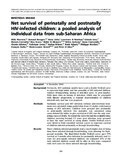| dc.contributor.author | Marston, M | |
| dc.contributor.author | Becquet, R | |
| dc.contributor.author | Zaba, B | |
| dc.contributor.author | Moulton, LH | |
| dc.contributor.author | Gray, G | |
| dc.contributor.author | Coovadia, H | |
| dc.contributor.author | Essex, M | |
| dc.contributor.author | Ekouevi, DK | |
| dc.contributor.author | Jackson, D | |
| dc.contributor.author | Coutsoudis, A | |
| dc.contributor.author | Kilewo, C | |
| dc.contributor.author | Leroy, V | |
| dc.contributor.author | Wiktor, S | |
| dc.contributor.author | Nduati, RW | |
| dc.contributor.author | Msellati, P | |
| dc.contributor.author | Dabis, F | |
| dc.contributor.author | Newell, ML | |
| dc.contributor.author | Ghys, PD | |
| dc.date.accessioned | 2013-06-12T09:46:00Z | |
| dc.date.available | 2013-06-12T09:46:00Z | |
| dc.date.issued | 2011-04 | |
| dc.identifier.citation | Int J Epidemiol. 2011 Apr;40(2):385-96. doi: 10.1093/ije/dyq255. Epub 2011 Jan 18 | en |
| dc.identifier.uri | http://www.ncbi.nlm.nih.gov/pubmed/21247884 | |
| dc.identifier.uri | http://erepository.uonbi.ac.ke:8080/xmlui/handle/123456789/32150 | |
| dc.description.abstract | BACKGROUND:
Previously, HIV epidemic models have used a double Weibull curve to represent high initial and late mortality of HIV-infected children, without distinguishing timing of infection (peri- or post-natally). With more data on timing of infection, which may be associated with disease progression, a separate representation of children infected early and late was proposed.
METHODS:
Paediatric survival post-HIV infection without anti-retroviral treatment was calculated using pooled data from 12 studies with known timing of HIV infection. Children were grouped into perinatally or post-natally infected. Net mortality was calculated using cause-deleted life tables to give survival as if HIV was the only competing cause of death. To extend the curve beyond the available data, children surviving beyond 2.5 years post infection were assumed to have the same survival as young adults. Double Weibull curves were fitted to both extended survival curves to represent survival of children infected perinatally or through breastfeeding.
RESULTS:
Those children infected perinatally had a much higher risk of dying than those infected through breastfeeding, even allowing for background mortality. The final-fitted double Weibull curves gave 75% survival at 5 months after infection for perinatally infected, and 1.1 years for post-natally infected children. An estimated 25% of the early infected children would still be alive at 10.6 years compared with 16.9 years for those infected through breastfeeding.
CONCLUSIONS:
The increase in available data has enabled separation of child mortality patterns by timing of infection allowing improvement and more flexibility in modelling of paediatric HIV infection and survival. | en |
| dc.language.iso | en | en |
| dc.publisher | University of Nairobi | en |
| dc.subject | HIV, survival, paediatric | en |
| dc.title | Net survival of perinatally and postnatally HIV-infected children: a pooled analysis of individual data from sub-Saharan Africa. | en |
| dc.type | Article | en |
| local.publisher | School of medicine,University of Nairobi | en |

